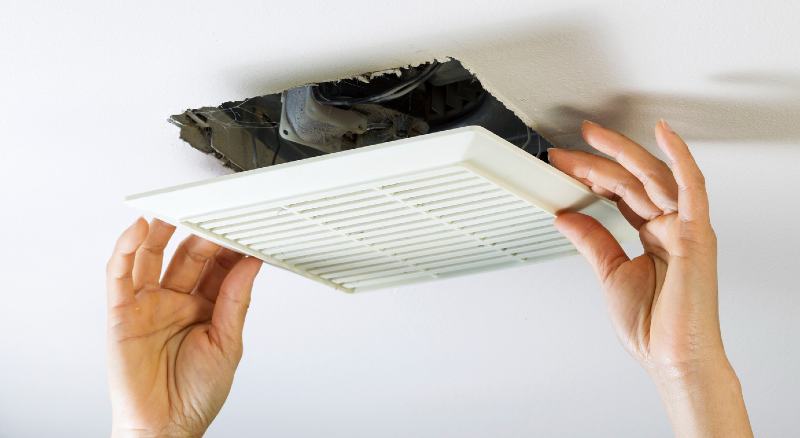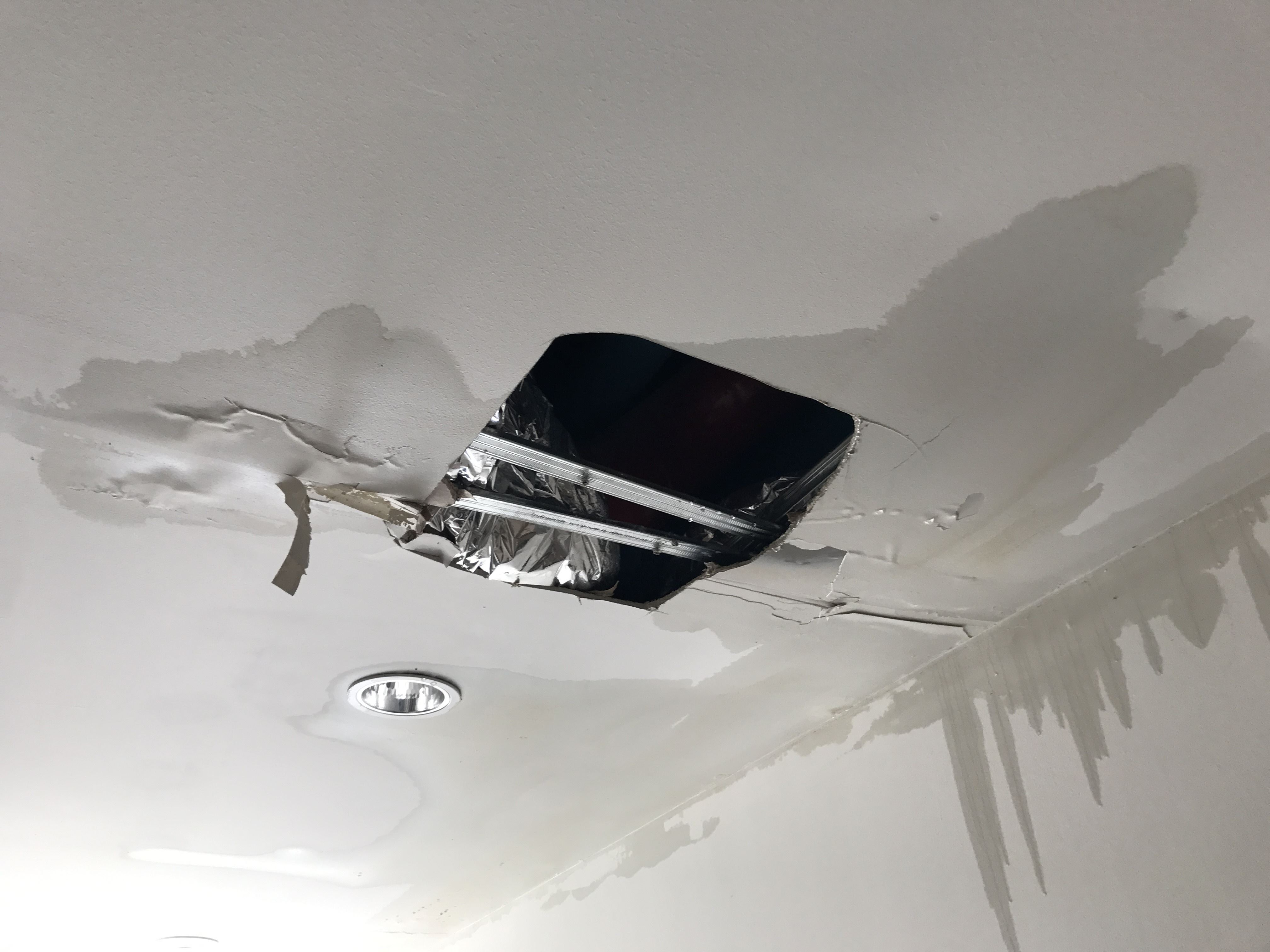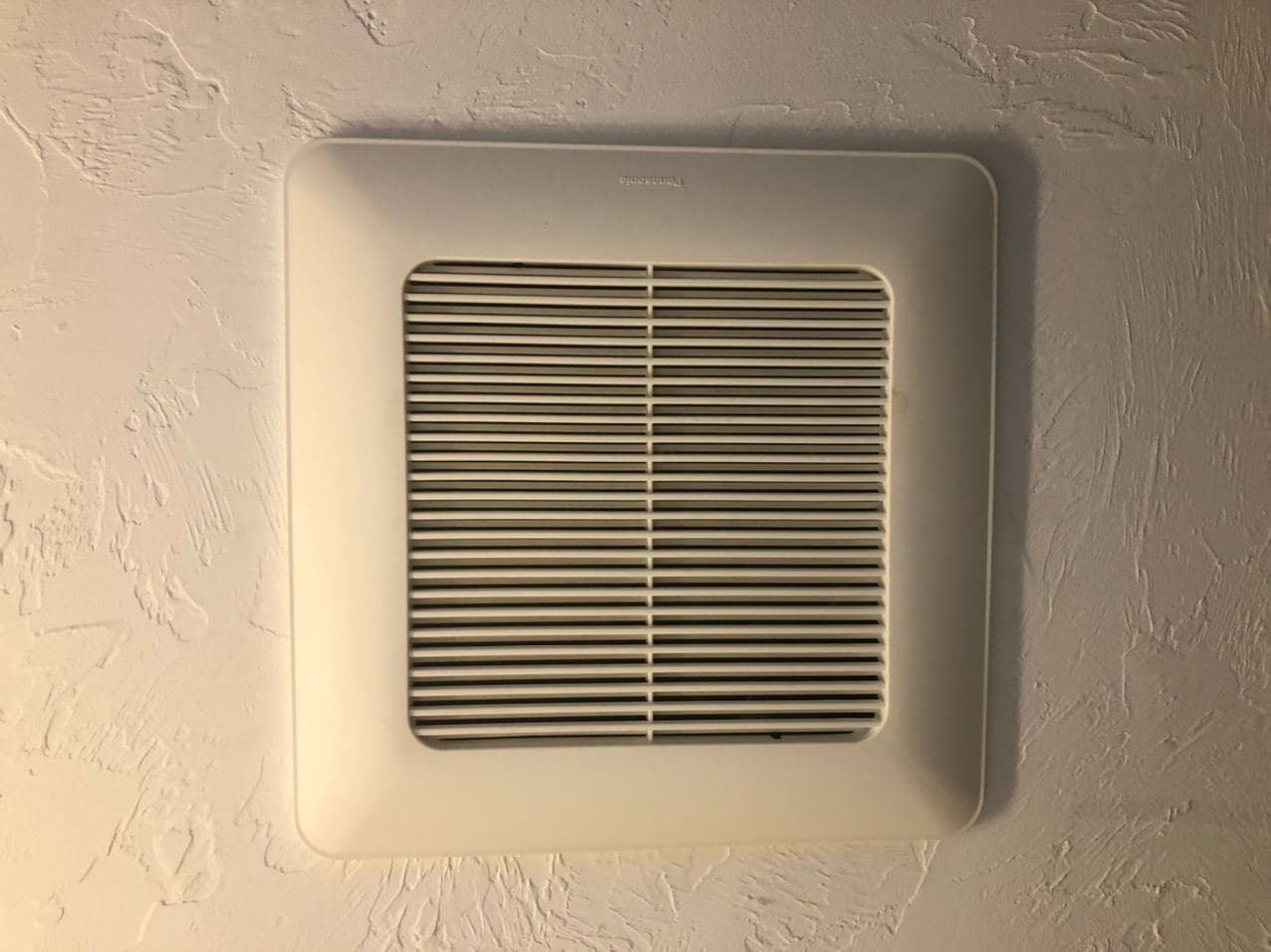Identifying the Source of the Leak: Leak In Bathroom Ceiling Vent

A leak in your bathroom ceiling vent can be a real headache, causing water damage and potential mold growth. To fix the problem, it’s crucial to find the source of the leak. This involves a careful inspection of the vent system and an understanding of the potential culprits.
Common Causes of Bathroom Ceiling Vent Leaks
Leaks in bathroom ceiling vents are usually caused by a few common factors. These include:
- Damaged Vent Pipes: Over time, vent pipes can become cracked, corroded, or disconnected, leading to leaks. This is especially common in older homes or where the vent system has been exposed to harsh weather conditions.
- Improper Installation: If the vent system was not installed correctly, it can lead to leaks. This could involve loose connections, inadequate sealing, or improper venting of the bathroom.
- Clogged Vent: A clogged vent can cause water to back up and leak into the ceiling. This is usually due to a buildup of debris, such as hair, lint, or soap scum, in the vent pipe.
- Roofing Issues: Leaks in the roof can sometimes travel down the vent system and into the bathroom ceiling. This is especially common in areas with heavy rainfall or snow.
Visual Inspection of the Vent System
A visual inspection of the vent system can help identify the source of the leak. Here’s a step-by-step guide:
- Locate the Vent: The vent pipe is typically located in the ceiling of the bathroom, near the exhaust fan. It’s often a round or square pipe made of metal or plastic.
- Check for Visible Damage: Look for any cracks, holes, or rust on the vent pipe. Inspect the connections between the pipe sections for loose or missing screws or sealant.
- Inspect the Vent Cover: Check the vent cover for signs of damage or improper sealing. If the cover is loose or cracked, it could allow water to leak into the bathroom.
- Check for Clogs: If you can access the vent pipe, look inside for any visible clogs. If you see any debris, try to remove it carefully.
Plumbing Fixtures and their Connection to the Vent
Plumbing fixtures in the bathroom can also contribute to leaks in the ceiling vent.
- Shower Head: A leaky shower head can send water down the vent pipe and into the ceiling. Check the shower head for signs of wear and tear, and make sure it’s properly connected to the shower arm.
- Faucet: A leaky faucet can also contribute to a vent leak. Check the faucet for any loose connections or signs of corrosion. Ensure the faucet is properly sealed and connected to the water supply line.
- Toilet: A leaking toilet can also cause water to travel down the vent pipe and into the ceiling. Check the toilet for any signs of leaks, such as water dripping from the tank or overflow tube.
Addressing the Leak

Once you’ve pinpointed the source of the leak, it’s time to tackle the problem head-on. Depending on the severity and location of the leak, you have several options to choose from. From simple patching and sealing to complete replacement, we’ll guide you through the process of restoring your bathroom ceiling vent.
Patching and Sealing
Patching and sealing are effective methods for addressing minor leaks in the bathroom ceiling vent. These methods involve filling small holes or cracks with appropriate materials to prevent water from seeping through.
- For small holes, you can use a patching compound like spackle or joint compound. Apply the compound to the hole, smooth it out, and allow it to dry completely. Once dry, you can sand the area to create a smooth finish.
- For larger holes or cracks, you may need to use fiberglass mesh tape or a patching kit. These kits usually include a patching compound and fiberglass mesh tape, which helps reinforce the repair and prevent further cracking.
- After patching, seal the area with a high-quality sealant or caulk. This will create a water-tight barrier and prevent future leaks.
Caulk and Sealant
Caulk and sealant play a crucial role in preventing leaks by filling gaps and cracks, creating a watertight seal. They come in various types, each suited for different applications.
- Silicone caulk is a popular choice for bathrooms because it’s waterproof, mold-resistant, and flexible. It’s ideal for sealing gaps around tubs, showers, and sinks.
- Acrylic caulk is another option, known for its paintability and ease of application. It’s suitable for sealing small cracks and gaps but may not be as durable as silicone caulk.
- Butyl caulk is a highly flexible sealant that’s often used for roofing and flashing applications. It’s also a good choice for sealing gaps around vents and pipes.
Replacement
In some cases, patching and sealing may not be enough to address the leak. If the vent is damaged beyond repair or the leak is persistent, replacement might be the best solution.
- You can purchase a new vent from your local hardware store or online retailer. Make sure to choose a vent that’s compatible with your existing bathroom ventilation system.
- Before installing the new vent, you’ll need to remove the old one. Carefully detach the vent from the ceiling and remove any fasteners or screws.
- Once the old vent is removed, install the new vent in its place. Secure it with the appropriate fasteners and ensure it’s properly sealed.
Comparing Repair Options
Here’s a table comparing the effectiveness and cost of different repair options:
| Repair Option | Effectiveness | Cost |
|---|---|---|
| Patching and Sealing | Effective for minor leaks | Low |
| Caulk and Sealant | Effective for sealing gaps and cracks | Low to Moderate |
| Replacement | Effective for major leaks or damaged vents | Moderate to High |
Preventing Future Leaks

The best way to deal with a bathroom ceiling vent leak is to prevent it from happening again. While a leaky vent can be a nuisance, addressing the root cause and implementing preventive measures can save you time, money, and stress in the long run.
Regular Maintenance and Inspection
Regular maintenance and inspection of your bathroom vent system are crucial to prevent leaks. A well-maintained system is less likely to develop issues that can lead to leaks.
- Inspect the vent fan: Ensure the fan is running smoothly and is not making any unusual noises. Check for any signs of damage or wear and tear.
- Clean the vent fan: Accumulated dust and debris can clog the fan and reduce its efficiency. Cleaning the fan regularly will help maintain its performance.
- Check the vent ductwork: Look for any signs of damage, cracks, or leaks in the ductwork. Ensure the ductwork is securely connected and properly sealed.
- Inspect the vent cover: Ensure the vent cover is securely in place and is not cracked or damaged. A loose or damaged vent cover can allow moisture to enter the vent system.
Preventative Measures, Leak in bathroom ceiling vent
Implementing preventative measures can significantly reduce the risk of future leaks.
- Avoid excessive moisture: Limit the amount of moisture that enters your bathroom by taking shorter showers, using exhaust fans, and opening windows for ventilation.
- Install a high-quality vent fan: Invest in a high-quality vent fan with a high CFM (cubic feet per minute) rating. A higher CFM rating means the fan can remove more moisture from the air.
- Ensure proper ventilation: Ensure that your bathroom has adequate ventilation. This means having a vent fan that is properly sized for the bathroom and that is vented to the outside.
- Check for leaks in the roof: A leaky roof can cause moisture to enter the vent system. Inspect your roof regularly for any signs of leaks and address them promptly.
- Inspect the plumbing: Check for leaks in your bathroom plumbing. Leaky pipes or fixtures can cause moisture to accumulate in the bathroom, leading to leaks in the vent system.
Homeowner Checklist for Leak Prevention
Here’s a checklist that homeowners can follow to proactively prevent leaks in their bathroom ceiling vent:
| Task | Frequency |
|---|---|
| Inspect vent fan for proper operation | Monthly |
| Clean vent fan | Quarterly |
| Inspect vent ductwork for damage | Annually |
| Inspect vent cover for damage | Annually |
| Check for leaks in the roof | Annually |
| Inspect bathroom plumbing for leaks | Annually |
Leak in bathroom ceiling vent – So, there’s this leak in my bathroom ceiling vent, right? It’s like a tiny waterfall, dripping on my head every time I shower. I’m thinking maybe I should just embrace the whole “rustic charm” thing and get some french country bathroom furniture to go with it.
But seriously, I need to fix that leak before it turns into a full-blown monsoon in my bathroom.
So, you’ve got a leak in your bathroom ceiling vent? That’s a classic case of “oh no, my house is slowly turning into a swimming pool.” But hey, at least you can distract yourself by picking out some new beige bathroom window curtains.
Maybe a nice calming shade of beige will make you forget about the leaky ceiling, at least for a few minutes. Just make sure you don’t get them too close to the vent, or you’ll have a whole new set of problems on your hands.